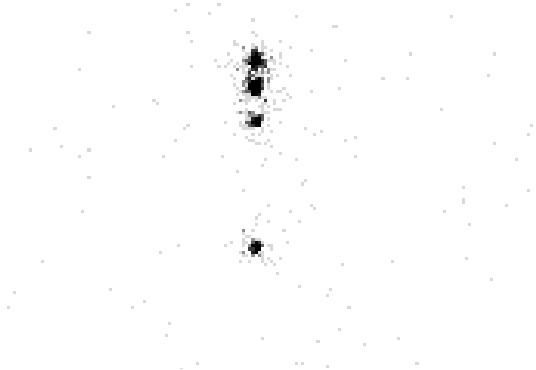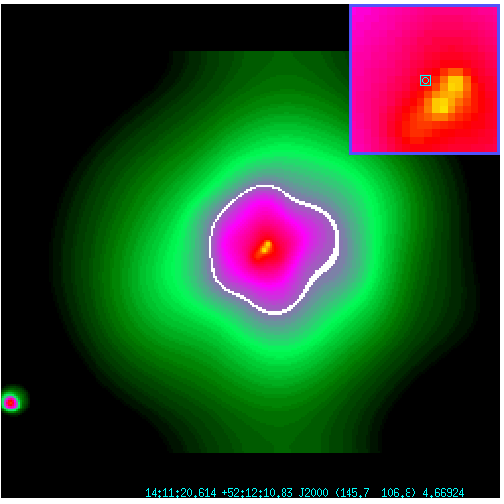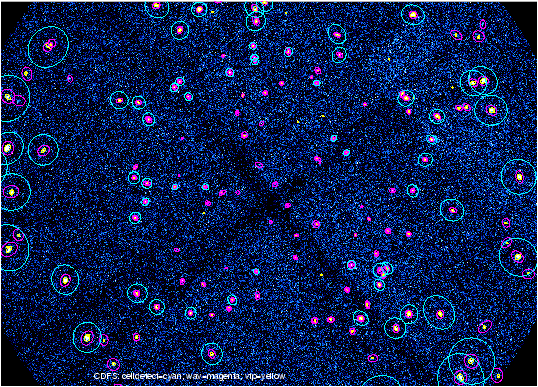Next: 3. Comparison of Detect Up: The Detect Reference Manual Previous: 1. A Tour of Contents
The sample datafiles used in the examples in this manual may be downloaded from:
http://cxc.harvard.edu/ciao/manuals.html
The Detect tools were designed primarily for the analysis of Chandra X-ray Observatory data, so the CXC has tested them using, in part, simulated ACIS and HRC data produced with the MARX 2.1simulator.
We use simulations so that we can seed the image with noise background plus a number of sources of known characteristics and then see how well various tools recover sources and their properties. The field constructed for ACIS is shown in Figures 2.1 and 2.2.
The simulation contains a background corresponding to a 30 ks exposure
and has 6 repetitions of a linear array of sources. The basic array
consists of 6 unresolved sources of the same intensity. From the
first source, the following 5 are spaced at 0.5, 4, 5, 10 and 30
arcsec. The pattern is repeated 60
![]() from the last of
these 6 sources, with the addition of an extended source at the final
position. That extended source is a Gaussian with a
sigma of 25
from the last of
these 6 sources, with the addition of an extended source at the final
position. That extended source is a Gaussian with a
sigma of 25
![]() . At right angles to this line of
sources, at a distance of 60
. At right angles to this line of
sources, at a distance of 60
![]() and
120
and
120
![]() , the pattern is repeated in two additional rows.
In the first of the three rows, the unresolved sources have
approximately 200 counts each (depending on the detector and off-axis
distance) and the extended source has about 2500 counts. For the
second row, the unresolved sources are much weaker with
, the pattern is repeated in two additional rows.
In the first of the three rows, the unresolved sources have
approximately 200 counts each (depending on the detector and off-axis
distance) and the extended source has about 2500 counts. For the
second row, the unresolved sources are much weaker with ![]() 30
counts each; the extended source intensity does not change. The last
row is the same as the middle row, except that the unresolved sources
are changed to discs with a diameter of 1
30
counts each; the extended source intensity does not change. The last
row is the same as the middle row, except that the unresolved sources
are changed to discs with a diameter of 1
![]() .
.
 |
3C 295 was observed with ACIS-S early in the mission as a calibration
observation. The target has several features useful for demonstrating
and comparing the Detect tools. The radio galaxy itself has a heavily
absorbed core which might be slightly resolved, but is close to being
a point source. Within a few arcsec to the north and south are
emission regions associated with the radio hotspots, thereby
presenting a test case for the separation of close sources. All of
these radio-associated sources are embedded in the extended emission
arising from the hot intracluster gas, for 3C 295 is within a cluster
of galaxies at ![]() . Hence the extended emission provides further
tests: detecting extended sources and separating unresolved sources
within extended emission.
. Hence the extended emission provides further
tests: detecting extended sources and separating unresolved sources
within extended emission.
An adaptively-smoothed version of the field center is shown in Figure 2.3. Most of the cluster emission is shown, and the insert gives a magnified view of the emission associated with the radio galaxy at the center.
This dataset was obtained from the Chandra Archive (ObsID 578). The examples focus on the chip S3 (ccd_id = 7) data, which contains over 100,000 events.
 |
3C 273 is probably the brightest nearby quasar in the radio band.
A prominent jet consisting of several brightness enhancements
("knots") begins about 12
![]() from the intense
unresolved X-ray core. The knots decrease in intensity with radial
distance. The faintest detectable emission is about 20
from the intense
unresolved X-ray core. The knots decrease in intensity with radial
distance. The faintest detectable emission is about 20
![]() from the core. The closely-spaced features in the jet provide a
good test of the Detect tools' ability to separate close
features. An HRC-I image of this source is shown in
Figure 2.4.
from the core. The closely-spaced features in the jet provide a
good test of the Detect tools' ability to separate close
features. An HRC-I image of this source is shown in
Figure 2.4.
This dataset was obtained from the Chandra Archive (ObsID 461), and contains over 800,000 events.
Having a very long (i.e. deep) exposure, such as the Chandra Deep Field South (CDFS) data, allows us to run Detect on real data with very conservative parameters and see how many real and spurious detections result.
For the CDFS, we have an long exposure of 991.45 ksec containing 1,927,235 counts. The short observation (ObsID 2405) is roughly 100 ksec and has 106,940 events. Each of these two datasets was filtered with a large circular region (radius = 8 arcmin) to avoid the edges which were not covered uniformly by all the merged ObsIDs that comprise these data.
To locate all real sources which might be detected by tools operating on the short segment, we ran celldetect with a S/N threshold of 5; wavdetect with 5 scales (1, 2, 4, 8, 16) and a signal threshold of E-6; and vtpdetect with a limit of E-7 false source events per number of background events. The resulting detections are shown in Figure 2.5.
 |
cxchelp@head.cfa.harvard.edu